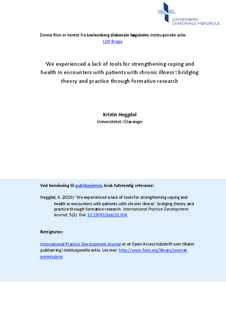| dc.contributor.author | Heggdal, Kristin | |
| dc.date.accessioned | 2016-11-02T09:44:37Z | |
| dc.date.available | 2016-11-02T09:44:37Z | |
| dc.date.issued | 2015-11-18 | |
| dc.identifier.citation | Heggdal, K. (2015) ‘We experienced a lack of tools for strengthening coping and health in encounters with patients with chronic illness’: bridging theory and practice through formative research. International Practice Development Journal, 5(2). Doi: 10.19043/ipdj.52.004 | nb_NO |
| dc.identifier.issn | 2046-9292 | |
| dc.identifier.uri | http://hdl.handle.net/11250/2418811 | |
| dc.description.abstract | Background: Healthcare personnel in specialist care in Norway took the initiative to develop their practice in order to improve follow-up of patients with chronic illness. A research project was constructed that involved a close collaboration between practice and research in the development of a new, complex intervention to strengthen patients’ ability to live with long-term conditions.
Aims and objectives: This paper seeks to describe a part of the research process that involved the firststage development of the intervention. The first objective is to describe how clinicians, patients and a health researcher collaborated, and to discuss the benefits of this collaborative work for improving practice. The second objective is to outline the intervention’s aspects and components.
Method: Three clinical sites were chosen for developing the intervention: a rehabilitation unit, an outpatient clinic and a centre for patient education. An interdisciplinary team of nine healthcare personnel and four patients engaged with the researcher(s) in the formative research. A list of criteria for reporting on the development of complex interventions was applied to elaborate on intervention components.
Results: An intervention was developed that entailed a person-centred approach to facilitating overall health in chronic illness. This involved a change in practice as the professionals acquired a new approach to the use of patients’ capacity for health, and as patients began to function as active partners in health promotion.
Conclusions: A close collaboration between clinicians, patients and researcher was necessary for developing a theory and a research-based intervention that improved the follow-up of individuals diagnosed with long-term conditions. The intervention was designed to be applicable across diagnostic categories and in a variety of clinical settings. These patients experience a multitude of challenges that require attention in health promotion. Therefore, health professionals should be encouraged by their leaders to engage in interdisciplinary collaboration with researchers in academia in developing new interventions for improving practice. Researchers who engage in such projects should be prepared to take on long-term collaboration.
Implications for practice:
• There is a need to develop the field of health promotion for long-term conditions, and especially a need to develop interventions to strengthen individuals’ capacity for health, empowerment and recovery
• An interdisciplinary project team is an advantage when developing interventions that aim to address the challenges experienced by individuals living with long term conditions
Partnership with patients in the design and testing of new interventions is necessary to maximise the relevance and suitability of the intervention.
Keywords: long term conditions, patient participation, health promotion, interdisciplinary, formative research, complex interventions | nb_NO |
| dc.language.iso | eng | nb_NO |
| dc.publisher | Centre for Nursing Innovation | nb_NO |
| dc.rights | Attribution-NonCommercial-NoDerivatives 4.0 Internasjonal | * |
| dc.rights.uri | https://creativecommons.org/licenses/by-nc-nd/4.0/ | * |
| dc.subject | Pasientmedvirkning | nb_NO |
| dc.subject | Spesialisthelsetjeneste | nb_NO |
| dc.title | ‘We experienced a lack of tools for strengthening coping and health in encounters with patients with chronic illness‘: bridging theory and practice through formative research | nb_NO |
| dc.type | Journal article | nb_NO |
| dc.type | Peer reviewed | nb_NO |
| dc.source.pagenumber | 17 | nb_NO |
| dc.source.volume | 5 | nb_NO |
| dc.source.journal | International Practice Development Journal | nb_NO |
| dc.source.issue | 2 | nb_NO |
| dc.identifier.doi | doi:10.19043/ipdj.52.004 | |
| dc.identifier.cristin | 1290605 | |

